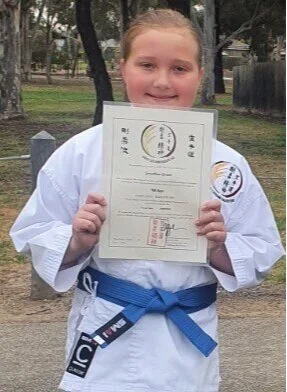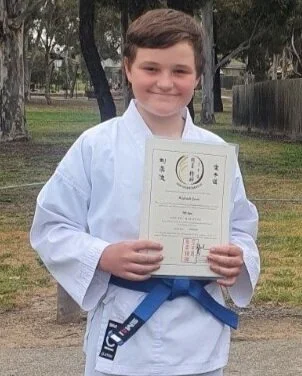|
Subscriber First Name͏ ͏ ͏ ͏ ͏ ͏ ͏ ͏ ͏ ͏ ͏ ͏ ͏ ͏ ͏ ͏ ͏ ͏ ͏ ͏ ͏ ͏ ͏ ͏ ͏ ͏ ͏ ͏ ͏ ͏ ͏ ͏ ͏ ͏ ͏ ͏ ͏ ͏ ͏ ͏ ͏ ͏ ͏ ͏ ͏ ͏ ͏ ͏ ͏ ͏ ͏ ͏ ͏ ͏ ͏ ͏ ͏ ͏ ͏ ͏ ͏ ͏ ͏ ͏ ͏ ͏ ͏ ͏ ͏ ͏ ͏ ͏ ͏ ͏ ͏ ͏ ͏ ͏ ͏ ͏ ͏ ͏ ͏ ͏ ͏ ͏ ͏ ͏ ͏ ͏ ͏ ͏ ͏ ͏ ͏ ͏ ͏ ͏ ͏ ͏
|
Newsletter #9 - October 2021
|

|
While we obviously prefer grading students in person, some students have shown wonderful resilience during lockdowns and have worked hard to progress their skills. We felt it appropriate to acknowledge the efforts of those students by adopting online gradings where appropriate. We are also seeing many students improving their skills moving closer to gradings, keep up the good work! |
|
|
Sorry we don’t have photos of everyone graded recently (we will need to catch up some grading shots when we are back in class), but we did manage to get these two. Well done to all who have been graded during these trying times. |
|

|
|
|
As soon as we are allowed to conduct classes we will be back! For up to date face to face class times in Term 4 please check our website ‘news’ page. We are still running free online classes and hope you can join us. Please contact us if you are not receiving email links. Current Schedule for free classes Tuesday 4.30pm - Junior White Belts - Karate Tuesday 5.00pm - Junior Blue Belts - Karate Tuesday 6.30pm - Tai Chi Wednesday 10.00am Tai Chi Wednesday 5.00pm Junior Green Belts - Karate Wednesday 5.30pm Junior Brown and Black Belts - Karate Wednesday 6.30pm Adult Karate Saturday 9.00am - Junior White Belts - Karate Saturday 9.30am - Junior Blue Belts - Karate Saturday 10.30am Junior Green Belts - Karate Saturday 11.00am Junior Brown and Black Belts - Karate Saturday 11.30 am Adult Karate
As restrictions allow, we aim to conduct some outdoor activities so please keep an eye on the websites news page and your emails.
|
Did you know we teach four different martial arts?- KARATE - TAI CHI - HSING I - BA GUA
|
|
If you, or anyone you know, are interested in trialing any of these classes, please contact us.
|
|
Our Karate school name is Goju Seishin Karate-do. The Japanese term “Seishin” means “Spirit” and refers a person with a strong mind, heart, or intention. “Goju” was adopted by Chojun Miyagi, founder of Goju Ryu (Hard Soft Way). Chojun Miyagi applied the term Goju (Hard/Soft), a concept found in the Bubishi, the original training manuals from China that influenced the development of karate in Okinawa.
|
|
Our style is based on Goju Kensha, a form of Goju Ryu karate developed by Tadahiko Ohtsuka Sensei (1940-2012). Tadahiko Ohtsuka was born in Tokyo on the 10th of June 1940. He started studying Goju-Ryu Karate in 1955 under the direction of Goju Master Sensei Sosui Ichikawa in Tokyo. A brilliant and dedicated student, Tadahiko Ohtsuka attained his 5th Dan ranking by 1965. In the same year he graduated in law from Meiji University. Two years later a meeting with Yo Meiji ("Yang Ming Shih" in Chinese) had a big impact on his life. As a result he developed a passion for Tai Chi Chuan. Then in 1968, he learnt Bagau Zhang and Hsing I Chuan through Master Wang Shu Chin from Taiwan. At the same time he studied techniques to maximise striking power with Shorin Ryu Master Yochuku Higa Sensei of Okinawa and drew on all these diverse arts to compliment and eventually create the Goju Kensha system.
|
|
The Tai Chi form we teach derives from an “Orthodox Style” developed in 1929. This style is synthesized from the five major schools (family styles) of Tai Chi Chuan. One of the driving goals in developing the “Orthodox Style” was the preservation of the essence of Tai Chi Chuan. The form incorporates an outline of the Yang style, the small frame of the Wu style and the characteristics and twisting of the Chen style.
|
|
Health Benifits Tai Chi Chuan has been shown to improve general health indicators such as; blood pressure, balance, posture, energy, flexibility, muscle strength, aerobic capacity and bone density According to an article in the Harvard Medical School Publication in 2009 “Tai Chi is often described as meditation in motion, but, it might well be called “medication in motion”. According to this article, there is growing evidence that this mind-body practice, which originated in China as a martial art, has value in treating and preventing many health problems.” “A growing body of carefully conducted research is building a compelling case for Tai Chi as an adjunct to standard medical treatment for the prevention and rehabilitation of many conditions commonly associated with age”, (Peter M. Wayne, assistant professor of medicine at Harvard Medical School).
|

|
Tai chi movements massage internal organs, releasing them from damaging constrictions brought about by stress, poor posture, and inappropriate working conditions. It aids improved breathing, helps the digestive system to work better and increases a sense of calmness and awareness and improved balance. |
|
|
|
Tai chi combines the physical components needed to stay upright—leg strength, flexibility, range of motion, and reflexes—all of which tend to decline with age.
|
|
What kind of martial art is Tai Chi? Tai Chi is an internal martial art. This means that every movement in the form must not only have self-defence applications, but must also strengthen the internal organs, joints and energy channels of the body. You might say that internal martial arts strengthen from the inside out, and external martial arts (like Karate or Taekwondo) strengthen from the outside in. Who can practice Tai Chi? Tai Chi can be practiced by people of all ages and fitness levels. It doesn’t require any special equipment, and can be practiced almost anywhere including the home and office. Health conscious individuals including world class athletes use Tai Chi to train and strengthen their mind and body through a series of slow motion postures and movements. How quickly will I learn? A beginner can start to reap the benefits of Tai Chi from day one as they begin to learn the postures and movements, however refining the movements can be a life long journey. Come and try - If you are interested in learning more about Tai Chi, the best way to find out is to come and try a class. We are hoping face to face classes will be able to resume soon. If not you, perhaps you know someone who would benefit.
|
|
Hsing-I is one of the oldest, most famous systems of Kung Fu and is known for its efficient and direct self defence moves. There is little known about the origins Hsing - I. Though not inventing the art himself, the first known person to bring the art to popularity amongst military ranks was General Yueh Fuei who died around 1130 A.D. Popular thought is that because of its advanced and sophisticated style it is believed to have been practice by many generations as early as 550 A.D Hsing - I is sometimes referred to as Chinese Mind-Body Boxing and refers to the ability of the mind to create an idea and project it into the body, creating a functional physical outcome. The apparent linear techniques of "Hsing I" incorporate many small, almost unseen movements that come together to create a highly effective fighting style.
|

|
Hsing-I Chuan’s five elements derived from the Chinese theory of the five main elements that make up the human body and the universe and their interactions with each other. These elements are metal, water, wood, fire, and earth, and are each represented by a specific technique. These techniques in turn are called Pi Chuan, Zhuan Chuan, Beng Chuan, Pao Chuan, and Heng Chuan. |
|
|
|
Ba Gua is considered the newest of the three main Chinese internal kung fu styles, the other two being Tai chi and Hsing - I. Dong Haichuan is widely credited as the founder of Ba Gua in the 19th century after he combined his knowledge of martial arts with the meditative circular walking of Taoist Monks.
|

|
Ba Gua Zhang originates from the I-Ching, or Book of Changes. Ba Gua means “eight diagrams/trigrams”. Zhang means palm and designates Ba Gua Zhang as a style of martial art, which emphasizes the use of the open hands. Ba Gua Zhang, as a martial art, is based on the theory of continuously changing in response to the situation at hand in order to overcome an opponent with skill rather than brute force. Training in Ba Gua Zhang teaches the practitioner to control his or her momentum and timing in order to generate power with the entire body mass. |
|
|

|
PRIVATE LESSONS We are also offering private video lessons which are proving popular with many. We charge two pre paid lessons for 30 minutes of private video tuition. As restrictions ease we will also be offering outdoor tuition so please keep an eye on the website news page and your emails |
|
|
|
MEMBERSHIP BENIFITS During our latest lockdown, all members have been invited to join our free online live classes. We have really enjoyed seeing your friendly faces, and thank you for joining us. As part of your annual membership with Wellbeing Martial Arts, you can access our online learning portal, a library of educational videos, through our website.
|
|
CONTACT For any queries please contact, Geoff - geoff@wellbeingmartialarts.com.au or 0419 599 206 Bree - bree@wellbeingmartialarts.com.au or 0419 364 320
|
|
|
|